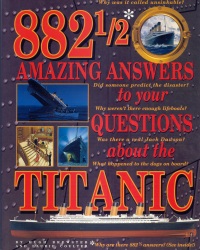| ________________
CM . . .
. Volume XIX Number 17. . . .January 4, 2013
excerpt:
882 ˝ Amazing Answers to Your Questions about the Titanic is a fantastic book. Strictly adhering to a question-and-answer format, the authors have nonetheless created a compelling read that contains multitudes of stories, stories that spill from question to question and from page to page. The authors have organized their questions and answers in chronological order. Early sections are "Birth of a Dream" and "Getting Ready". Details of the voyage and sinking follow while the story is brought nearly up to date in the concluding sections on the discovery of the wreck, modern films and so on. Although this book can be opened to any page and browsed at will, I found that the thematic grouping of questions made for a compelling read straight through. The 882 1/2 answers in this book truly are amazing - both for the scope of information they cover as well as for the depth of details given. As in the above extracts, the questions and answers provide important context for young readers (such as the origin of the word “saloon”) as well as specific details about life on board the ship – for staff as well as for adult passengers and children, too. The book benefits from excellent layout and graphic design. Questions and answers are arranged in attractive two-page spreads that use paintings, drawings, photographs, and charts to break up the text. Pleasantly asymmetrical columns of text, adequate white space, text boxes, bolding, bullets and shading make it easy to match each question with its answer. The paintings, by Ken Marschall, are excellent while the photographs and charts add instant value to the text, illustrating events and people and offering visual explication of concepts and occurrences. Text and illustrations are nicely balanced on the page. The above extracts from the text do not do justice to the beautiful presentation of the questions and answers in the book. My only quibble with the book is that it is a straight reprinting of the first edition, published in 1998. Generally speaking, this makes no difference to its content, although answer 734, identifying the living survivors of the Titanic, remains dated at 1998. Librarians will want to have several copies of this book available for eager borrowers. This book is an essential companion to any other book or movie on the subject. Highly Recommended. Greg Bak teaches archival studies at the University of Manitoba’s Department of History in Winnipeg, MB.
To comment
on this title or this review, send mail to cm@umanitoba.ca.
Copyright © the Manitoba Library Association. Reproduction for personal
use is permitted only if this copyright notice is maintained. Any
other reproduction is prohibited without permission.
NEXT REVIEW |
TABLE OF CONTENTS FOR THIS ISSUE
- January 4, 2013.
AUTHORS |
TITLES |
MEDIA REVIEWS |
PROFILES |
BACK ISSUES |
SEARCH |
CMARCHIVE |
HOME |
